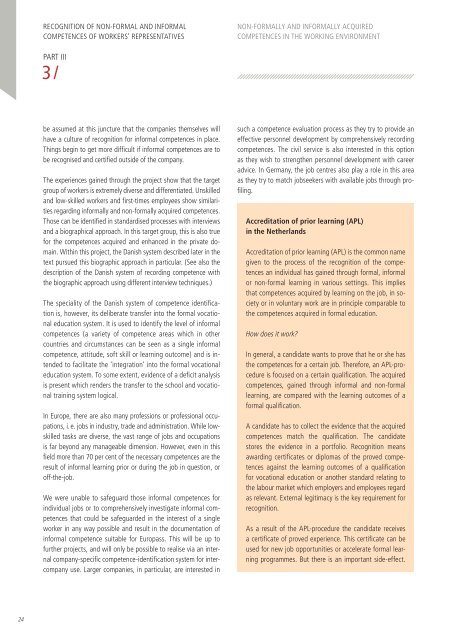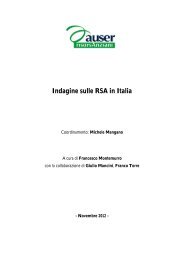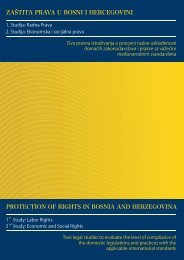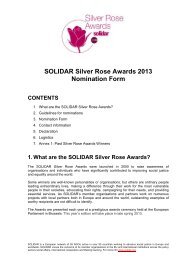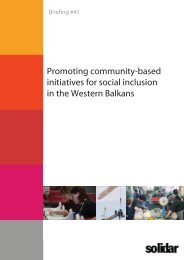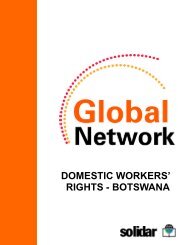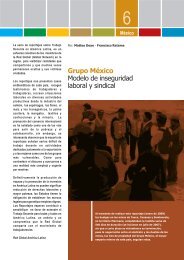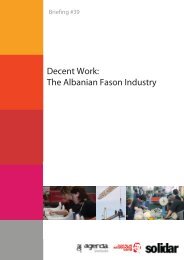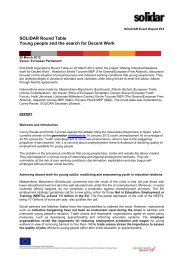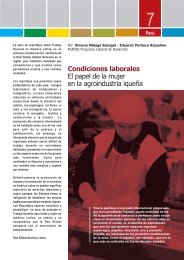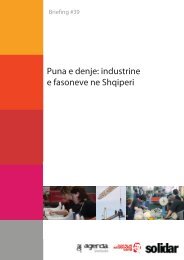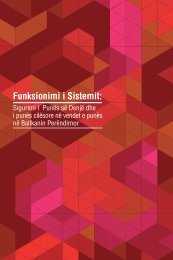RECOGNITION OF NON-FORMAL AND INFORMAL ... - Solidar
RECOGNITION OF NON-FORMAL AND INFORMAL ... - Solidar
RECOGNITION OF NON-FORMAL AND INFORMAL ... - Solidar
Create successful ePaper yourself
Turn your PDF publications into a flip-book with our unique Google optimized e-Paper software.
<strong>RECOGNITION</strong> <strong>OF</strong> <strong>NON</strong>-<strong>FORMAL</strong> <strong>AND</strong> IN<strong>FORMAL</strong><br />
COMPETENCES <strong>OF</strong> WORKERS’ REPRESENTATIVES<br />
<strong>NON</strong>-<strong>FORMAL</strong>LY <strong>AND</strong> IN<strong>FORMAL</strong>LY ACQUIRED<br />
COMPETENCES IN THE WORKING ENVIRONMENT<br />
PART III<br />
3 /<br />
be assumed at this juncture that the companies themselves will<br />
have a culture of recognition for informal competences in place.<br />
Things begin to get more diffi cult if informal competences are to<br />
be recognised and certifi ed outside of the company.<br />
The experiences gained through the project show that the target<br />
group of workers is extremely diverse and differentiated. Unskilled<br />
and low-skilled workers and fi rst-times employees show similarities<br />
regarding informally and non-formally acquired competences.<br />
Those can be identifi ed in standardised processes with interviews<br />
and a biographical approach. In this target group, this is also true<br />
for the competences acquired and enhanced in the private domain.<br />
Within this project, the Danish system described later in the<br />
text pursued this biographic approach in particular. (See also the<br />
description of the Danish system of recording competence with<br />
the biographic approach using different interview techniques.)<br />
The speciality of the Danish system of competence identifi cation<br />
is, however, its deliberate transfer into the formal vocational<br />
education system. It is used to identify the level of informal<br />
competences (a variety of competence areas which in other<br />
countries and circumstances can be seen as a single informal<br />
competence, attitude, soft skill or learning outcome) and is intended<br />
to facilitate the ‘integration’ into the formal vocational<br />
education system. To some extent, evidence of a defi cit analysis<br />
is present which renders the transfer to the school and vocational<br />
training system logical.<br />
In Europe, there are also many professions or professional occupations,<br />
i. e. jobs in industry, trade and administration. While lowskilled<br />
tasks are diverse, the vast range of jobs and occupations<br />
is far beyond any manageable dimension. However, even in this<br />
fi eld more than 70 per cent of the necessary competences are the<br />
result of informal learning prior or during the job in question, or<br />
off-the-job.<br />
We were unable to safeguard those informal competences for<br />
individual jobs or to comprehensively investigate informal competences<br />
that could be safeguarded in the interest of a single<br />
worker in any way possible and result in the documentation of<br />
informal competence suitable for Europass. This will be up to<br />
further projects, and will only be possible to realise via an internal<br />
company-specifi c competence-identifi cation system for intercompany<br />
use. Larger companies, in particular, are interested in<br />
such a competence evaluation process as they try to provide an<br />
effective personnel development by comprehensively recording<br />
competences. The civil service is also interested in this option<br />
as they wish to strengthen personnel development with career<br />
advice. In Germany, the job centres also play a role in this area<br />
as they try to match jobseekers with available jobs through profi<br />
ling.<br />
Accreditation of prior learning (APL)<br />
in the Netherlands<br />
Accreditation of prior learning (APL) is the common name<br />
given to the process of the recognition of the competences<br />
an individual has gained through formal, informal<br />
or non-formal learning in various settings. This implies<br />
that competences acquired by learning on the job, in society<br />
or in voluntary work are in principle comparable to<br />
the competences acquired in formal education.<br />
How does it work?<br />
In general, a candidate wants to prove that he or she has<br />
the competences for a certain job. Therefore, an APL-procedure<br />
is focused on a certain qualifi cation. The acquired<br />
competences, gained through informal and non-formal<br />
learning, are compared with the learning outcomes of a<br />
formal qualifi cation.<br />
A candidate has to collect the evidence that the acquired<br />
competences match the qualifi cation. The candidate<br />
stores the evidence in a portfolio. Recognition means<br />
awarding certifi cates or diplomas of the proved competences<br />
against the learning outcomes of a qualifi cation<br />
for vocational education or another standard relating to<br />
the labour market which employers and employees regard<br />
as relevant. External legitimacy is the key requirement for<br />
recognition.<br />
As a result of the APL-procedure the candidate receives<br />
a certifi cate of proved experience. This certifi cate can be<br />
used for new job opportunities or accelerate formal learning<br />
programmes. But there is an important side-effect.<br />
24


